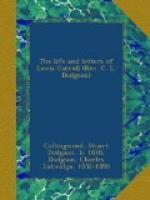The critics were loud in their praises of “Alice”; there was hardly a dissentient voice among them, and the reception which the public gave the book justified their opinion. So recently as July, 1898, the Pall Mall Gazette conducted an inquiry into the popularity of children’s books. “The verdict is so natural that it will surprise no normal person. The winner is ‘Alice in Wonderland’; ’Through the Looking-Glass’ is in the twenty, but much lower down.”
“Alice” has been translated into French, German, Italian, and Dutch, while one poem, “Father William,” has even been turned into Arabic. Several plays have been based upon it; lectures have been given, illustrated by magic-lantern slides of Tenniel’s pictures, which have also adorned wall-papers and biscuit-boxes. Mr. Dodgson himself designed a very ingenious “Wonderland” stamp-case; there has been an “Alice” birthday-book; at schools, children have been taught to read out of “Alice,” while the German edition, shortened and simplified for the purpose, has also been used as a lesson-book. With the exception of Shakespeare’s plays, very few, if any, books are so frequently quoted in the daily Press as the two “Alices.”
In 1866 Mr. Dodgson was introduced to Miss Charlotte M. Yonge, whose novels had long delighted him. “It was a pleasure I had long hoped for,” he says, “and I was very much pleased with her cheerful and easy manners—the sort of person one knows in a few minutes as well as many in many years.”
[Illustration: C. M. Yonge. From a photograph by Lewis Carroll.]
In 1867 he contributed a story to Aunt Judy’s Magazine called “Bruno’s Revenge,” the charming little idyll out of which “Sylvie and Bruno” grew. The creation of Bruno was the only act of homage Lewis Carroll ever paid to boy-nature, for which, as a rule, he professed an aversion almost amounting to terror. Nevertheless, on the few occasions on which I have seen him in the company of boys, he seemed to be thoroughly at his ease, telling them stories and showing them puzzles.
I give an extract from Mrs. Gatty’s letter, acknowledging the receipt of “Bruno’s Revenge” for her magazine:—
I need hardly tell you that the story is delicious. It is beautiful and fantastic and childlike, and I cannot sufficiently thank you. I am so proud for Aunt Judy that you have honoured her by sending it here, rather than to the Cornhill, or one of the grander Magazines.
To-morrow I shall send the Manuscript to London probably; to-day I keep it to enjoy a little further, and that the young ladies may do so too. One word more. Make this one of a series. You may have great mathematical abilities, but so have hundreds of others. This talent is peculiarly your own, and as an Englishman you are almost unique in possessing it. If you covet fame, therefore, it will be (I think) gained by this. Some of the touches are so




